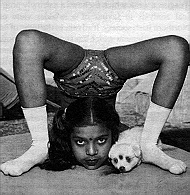Teachings from Yoga and
Buddhism for Living
An Engaged Life
Michael Stone
(Shambhala)

Stone's treatise fits right in with this information. He opines that we might do less twisting and, rather, get "engaged with the world. "
- I suggest we aim for a secular Yoga that is alive and responsive to contemporary life, not an attempt at practicing exotic prayers and rituals that have no resonance or deep effect in our personal lives and commitments.
Stone is a resourceful teacher, and in these twenty lectures, he touches on the natural world, money, diversity, nonduality, "The Breath Cycle," "The Object of Meditation," and "Suicide." Many of his comments make eminently good sense.
Samadhi is the state of ecstasy (or enlightenment) that comes from a deep surrender to the principles of Yoga. "All kinds of people enter into samadhi all the time without knowing anything about it," he says. (Yogin know that those of us who are struggling to chase down enlightenment will never get it. As Buddhist Barry Corbet once said, "If you are trying to get it, you won't get it.")
 Then there is dying. Stone suggests that we accept the fact that we are dying, constantly. It is not something that happens one day: "If we can understand that dying and change are happening moment to moment, then death [need not be] projected into the future."
Then there is dying. Stone suggests that we accept the fact that we are dying, constantly. It is not something that happens one day: "If we can understand that dying and change are happening moment to moment, then death [need not be] projected into the future."
In a lecture on diversity, Stone reminds us that to be human is to be at one with the elements. We are everything that we see and feel and do. "One finds little distinction between all forms of life," he says, and then he quotes from the Purusa Sukta,
- The moon was born from his mind;
His eyes gave birth to the sun;
And the wind was formed from his breath
From his navel arose the central axis;
From his feet, the earth; from ears, all the directions,
From all of this the world was formed.
Stone is trying to get us away from the concept of Yoga as something out there that we pick up and ... being westerners, immediately try to own. He suggests we even change the yogic language. "It is most helpful then to replace the term enlightenment with intimacy and the word realization with relationship."
- Yoga is the restoration of intimacy through body, mind, and heart, and the key is always the observation of the breath. The breath regulates the body, which in turn regulates the mind, which in turn determines the quality of attention on the breath.
The author emphasizes again that it is not something that we can control. Rather, it's there, and, at the same time, not there. If you want to change the inhale, concentrate on the exhale.
Sometimes all this gets a bit heavy. "Waves and water cannot be separated," he writes. "You are a wave and life is water."
- Everything that exists is whispered though our breath, courses through our bloodstream, and adheres to our changing cells.
The best chapter here treats with suicide. As a psychotherapist, Stone is often faced with those threatening to take their own lives. "Every year, worldwide, an estimated three-quarters of a million people take their own life," he reports. Psychiatrists and psychologists "contract for safety with suicidal patients," which involves a promise by the patient to contact their helpers if the "inclination to commit suicide overwhelms them."
 Stone says, flatly, that "Such contracts don't work." Because the mental state of the patient is not static, they may have "inconsistent and complex motivations for agreeing to or refusing a contract." He tells us that suicide moves from being one option to being the option when meaningless grows.
Stone says, flatly, that "Such contracts don't work." Because the mental state of the patient is not static, they may have "inconsistent and complex motivations for agreeing to or refusing a contract." He tells us that suicide moves from being one option to being the option when meaningless grows.
And how is one to defeat such inclinations. He suggests a controversial plan: the therapist must buy into the idea that suicide is a viable solution. "Can we hear the pain of our friend who is dying to die?" In these cases, "there are no rules." He gives an example of a young man who has told him he will go through with it. Stone explains that he knows his pain. The young man says that no one knows his pain. He says "Pain is pain. Deadly is me. I am dead." Stone replies,
- If you are dead now, what have you got to lose?
"We had each other cornered," he writes: "The arguing made us both feel alive." He shows how thus he and the young man were able to save his life.